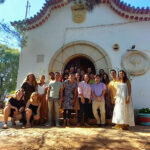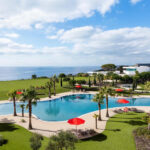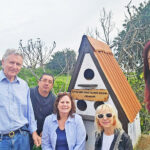By João C. Duarte – University of Lisbon
On the morning of the 1st November 1755, a major earthquake struck off southwest Portugal.
With an estimated magnitude of 8.5, this was the biggest earthquake ever felt in Europe, Africa and the Atlantic. It became known as the Great Lisbon Earthquake. Today we still do not know what caused it, but we may be close to finding out.
The morning of All Saints Day started with glorious sunlight. The sky was blue and a soft breeze was blowing. Everyone was excited about the religious festivities and rushed to the morning Mass. Around 9.30 a.m., the ground started to move, with a gentle motion. Then whole buildings began to shake, while a strange thunder-like noise was heard underground. Everything was over in less than a minute. A few seconds after, a big crash! The buildings started to move with such violence that everything was thrown out of its place. The noise was so loud it felt like all the buildings in town had fallen at the same time. The roof of the churches collapsed, leaving a large number of the Lisbon population dead or severely wounded.
The second shock lasted for about 10 minutes, an eternity for those who managed to escape to open ground near the riverfront. That seemed to be the safest place. It was not. Forty minutes after, three giant waves rolled down the Tagus River, flooding the city with waves up to six metres. At the same time, a strong replica hit the city again, collapsing the few buildings still standing. Major fires erupted because of the thousands of candles that were lit for Mass. The fires spread all over the city and lasted for days. It is difficult to estimate, but the earthquake, the tsunami and fires combined may have killed several tens of thousands of people, leaving the city of Lisbon a wreck.
The impact of the Lisbon earthquake was enormous. The ground motion was felt as far as Germany, and the tsunami caused great destruction on the coast as far as Ireland and the Caribbean. This was The Enlightenment period and philosophers such as Voltaire, Rousseau and Kant readily became interested in the phenomenon. Countless texts were written about the Lisbon disaster. Of particular interest are three reports written by Emmanuel Kant in 1756 on the causes of earthquakes. For some, this is considered the birth of modern seismology, and of our understanding of modern geology. Kant recognised that earthquakes often concentrate and align along mountain chains, and estimated the area of the seafloor that had to move in order to produce the observed tsunami. He clearly understood, using the fresh physics of Isaac Newton, that the earthquake and the tsunami resulted from the propagation of mechanical waves.
Another extremely important contribution was an enquiry made of 13 questions, prepared by the minister of the King, the Marquis de Pombal, and sent to all parishes. Pombal’s questionnaire allows us to produce very accurate and statistically meaningful intensity maps and to position the source of the Lisbon earthquake 200 km to the west of the Cape St Vincent, near the Gorringe Bank. The Gorringe Bank is a 5000-metre submarine mountain formed as the result of the activity of an underwater tectonic fault.
On 28th February 1969, at around 2.40 a.m., another major earthquake, with a magnitude of 7.9, struck the southwest coast of Portugal. It was overnight and did not cause any fatalities, even though it produced a small tsunami. Over the last few decades, many efforts have been made to locate the source of these earthquakes. In particular, in the early Seventies, several studies led by British scientists at Cambridge tried to explain the origin of the 1969 earthquake. Later, French, Spanish, Portuguese and Italian teams joined in. This was in part because these earthquakes were not supposed to occur in that location! Why not?
In the late Sixties, geosciences underwent a revolution that led to a new unified theory of the Earth: The Theory of Plate Tectonics. According to this new theory, the surface of the Earth was broken up into several tectonic plates that moved in relation to each other, while many fundamental geological processes occur at plate boundaries. These processes include the formation of mountains, volcanic activity and earthquakes. Scientists also realised the margins of the Pacific Ocean, where one plate plunges under another, are responsible for major earthquakes and host the most active volcanoes on Earth (the famous ring of fire). But the margins of the Atlantic Ocean are quiet and do not host major earthquakes. In fact, earthquakes with a magnitude higher than 7 or 8 are extremely rare in the Atlantic. So, what may have caused the earthquakes of 1755 and 1969?


To explain this apparent paradox, it was soon proposed that in the Portuguese margin a tectonic plate could just be starting to plunge under another. This was concerning but exciting! Such a process is rare and poorly understood, despite it being part of the grand natural dynamics of our planet, the same dynamics that allow the existence of life on its surface. It is known that oceans are born and grow, such as the Atlantic which was born as a consequence of the breakup of Pangea, and will one day start to close, before another supercontinent forms. The plunging of oceanic plates in the Earth’s mantle marks precisely the moment in which one ocean starts to close, meaning that the Atlantic may be fated to disappear. The 1755 Great Lisbon Earthquake may have been its prelude.
But there is no reason for alarm. These processes take many millions of years, and it will take at least another 100 million years for the Atlantic Ocean to vanish.
The movement of the plates is also relatively slow in this region, meaning that earthquakes such as the one of 1755 are rare. Notwithstanding, lower magnitude earthquakes can happen at any time, and our best strategy to mitigate their impact is knowledge. It is very important to know what to do in case of an earthquake, and a potential subsequent tsunami. Portugal presently has strict construction rules and has recently implemented a tsunami warning system. A real-time earthquake alert system may also be underway, in which we may be warned a few seconds in advance (by a text message) that a strong earthquake will be felt. This is possible because most of the earthquakes occur far from the coast and take some time to arrive inland.
With the contribution of everyone, I believe we are much better prepared to face the next seismic events.

João Duarte is an Assistant Professor at the Geology Department, at Faculty of Sciences of the University of Lisbon, Portugal, and a Researcher at the Instituto Dom Luiz (IDL), where he coordinates the Research Group on Continental Margins and Deep Ocean Frontiers and the Earth systems Doctoral School. After obtaining his PhD from the University of Lisbon in 2012, he moved to a Postdoctoral position.
He has collaborated with popular science magazines such National Geographic and New Scientist, as well as with TV channels (including BBC, ZDF and NHK). In 2015, João was awarded the Discovery Early Career Researcher Award (DECRA) from the Australian Research Council, and in 2017, he received the Arne Richter Award for Outstanding Early Career Scientists of the European Geosciences Union (EGU).
João has published more than 40 papers in high-quality, specialised journals and has edited two books about tectonics. He is also currently a member of the editorial board of the Nature Research journal Communications Earth and Environment.













